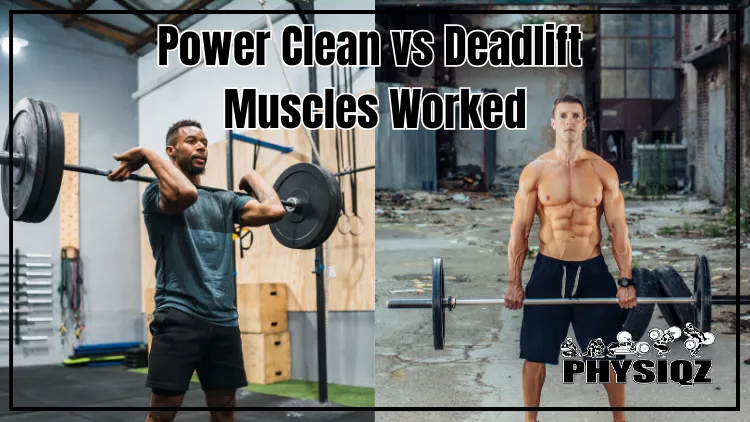
Between the power clean vs deadlift, the muscles worked are extremely similar, even when keeping in mind the different clean variations like the hang clean, clean press, and squat clean.1 The effectiveness of the deadlift and power clean for strength development and overall athleticism should be evaluated.
To better understand the answers to these questions, some foundational understanding of the two different movements should be understood, including understanding the different muscles worked through each one, how to stay safe and the benefits one can garner when performing them, and which one should be performed when trying to achieve different body goals.
Before delving into these more intricate concepts, it’s important to first examine the distinctions between the power clean and deadlift.
Power Clean vs Deadlift: What’s the Difference?
One core difference between the power clean and the deadlift lies in the path that the bar follows. When a lifter does a power clean, they rapidly pull the weight off of the floor, using the momentum to launch it up to their shoulders, subsequently inverting their arms to end in a position similar to the starting point for an overhead press.
The deadlift, on the other hand, starts at the bottom position of a squat with a flexed lower back and a tight core. Pushing through their heels, the lifter straightens their knees and ends the movement by thrusting through the hips, ending with the bar right in front of the pelvis.
A more intuitive way to envision it is that its bar path is essentially the inverse of the squat bar path — instead of going straight down and back up, it goes straight up and then straight down.
For readers who think that the power clean seems like a combination of the deadlift and another movement, they’d be correct. When performing it, the weightlifter deadlifts the barbell straight from the ground, but the second portion of it — where it is flung up to their shoulders — is different from the deadlift entirely.
To some, this might suggest that the power clean is a ‘better’ movement since it uses a couple more muscles and requires a greater degree of coordination, mobility, and overall athleticism.
But, this is simply not the case — the deadlift, by default, allows more weight to be lifted than possible when power cleaning, so there is an immensely greater ability to overload the muscles with more weight when deadlifting.
Think about it logically: the deadlift solely requires for the bar to be raised off of the floor to hip height. But when doing the power clean, the barbell is lifted and then propelled up to the shoulders, which significantly limits the potential weight that can be lifted when performing it.
So, to recap what was just discussed above: the deadlift has a higher weight potential for what can be put on the bar compared to the clean due to the bar path that is followed in the movements. As such, the muscles worked in the power clean vs deadlift do differ slightly.
Comparing Muscles Worked in Deadlifts & Power Cleans
The muscles that the power clean and deadlift work are very similar, but as already stated, the power clean is a better movement for athleticism while the deadlift is better for developing holistic strength in the entirety of the body.
The power clean works the following muscles:
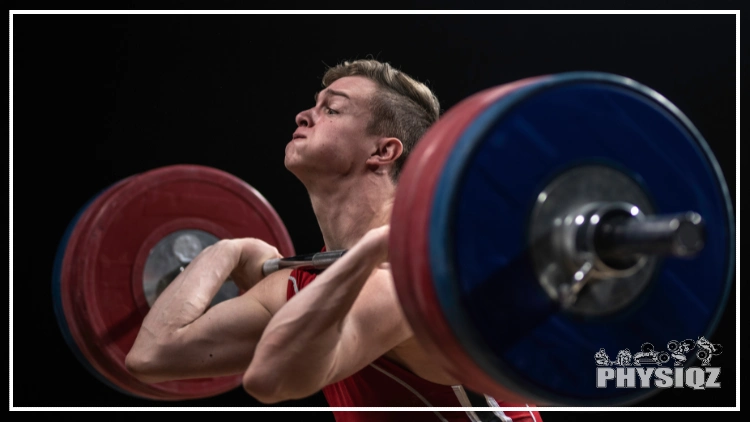
Source: vm via Canva.com2
Quadriceps, glutes, and hamstrings: The quads, hamstrings, and glutes are used to explosively push through the heel to straighten the knee, with the hamstrings and glutes acting as primary movers at the bottom of the range of motion, with the quads being placed under a higher amount of tension once the bar is caught at the shoulders.
As a whole, the power clean tends to target the glutes and hamstrings slightly more than the quads because the knee is not being extended; rather, the hips are, and hip-hinging movements are always slightly biased towards the glutes and hams.
Trapezius, rhomboids, and rear deltoids: The traps and rhomboids are active at the bottom position of the power clean to help retract the scapula while keeping the torso upright, and the rear delts are marginally activated when the barbell is caught to help stabilize the arms by keeping the shoulders locked into place.
Proper scapular retraction is extremely important throughout the power clean. Without retracting the scapula and ensuring it is locked into place throughout the majority of the motion, it could easily lead to injuries stemming from letting the bar’s momentum swing the arms too far from the body.
The safety of the power clean and deadlift are something we’ll discuss further along in this article since it is important to keep in mind.
Lower back: While the abs are not that involved throughout the power clean, the lower back is moderately activated to help stabilize when pulling the weight from the floor (the deadlift portion of the movement). However, compared to the deadlift, the lower back is significantly less important in the power clean, but even still, according to research, the power clean elicits a high amount of activation in the erector spinae muscles, making it beneficial for developing the erector spinae muscles when proper form is maintained.3
Forearms: Obviously, since the clean is a type of pull, and the barbell is pulled from a standstill position, the forearms have to grip the bar and maintain that grip throughout the entirety of the movement. This is worth noting because if a person who is trying to perform a power clean has weak forearms, they will almost certainly struggle with even the starting position of the clean or deadlift.
The deadlift works virtually all of the same muscles as the power clean, but there are a few core differences that should be noted:
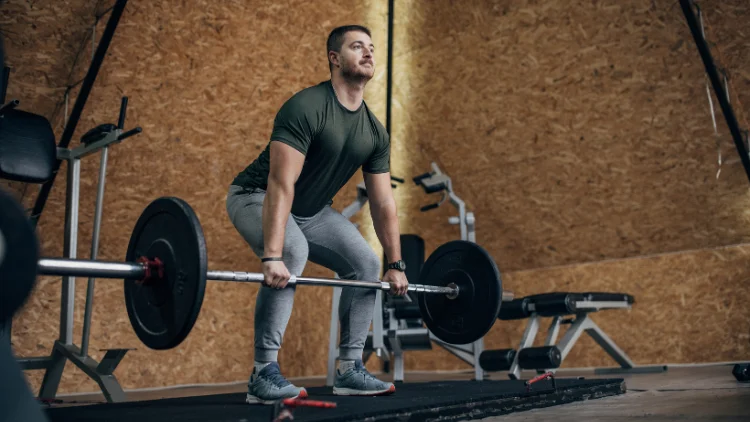
Source: Hirurg via Canva.com4
Hamstrings and glutes: The deadlift technically works the quads when straightening the knee, since that is the main function of the quadricep muscle, but they are not activated as much as in the power clean. By default, this means that the glutes and hamstrings are the two primary leg muscles activated in the deadlift.
This means that as part of a progressive overload workout plan, a lifter can load more weight onto their glutes and hams by performing the deadlift over the power clean.
Trapezius (traps) and rhomboids: Similarly to the power clean, the traps and rhomboids are active in the starting portion of the deadlift to help retract the scapula pulling from the floor. Note that this is a crucial portion of the deadlift — if the scapula is not properly retracted, a person can easily damage their rotator cuff or potentially over-round their spine.
The traps and rhomboids receive a similar level of stimulus when compared to the clean overall since both movements necessitate firm scapular retraction to ensure that the starting portion of each of them is safe. This is extremely important to keep in mind when deadlift; when performing the movement, start it off by pulling the shoulder blades back and down, imagining they are being put into a back pocket.
This is the best cue to ensure the scapula is properly retracted into a safe, stable position.
The rear deltoids, on the other hand, receive very little stimulus when deadlifting. They are activated in the power clean since the rear delts serve to stabilize the shoulder joint when the bar is caught, but there is no part of the deadlift where this happens, hence, minimal activation.
Abdominals: Since the back is flexed when performing a deadlift, and more weight is lifted when compared to the power clean, the abs have to work harder to keep the lower back in a safe, neutral position. Overall, though, there is a similar amount of activation of the core musculature in both the power clean and deadlift — it’s just that the latter allows for a greater total amount of stress to be placed on the body.
Lower back: In the deadlift, the ending position of the bar is at the hips, the movement ending with the lifter thrusting through their hips. This way of ‘locking out’ places more of an emphasis on strength in the lower back than the power clean does.
After the hips are locked out, they have to keep the barbell in place, which influences the way force is dispersed in the body in multiple ways.
Since the bar’s center of mass is in front of the body, this forces the erector spinae muscles to contract to a high degree to prevent the spine from collapsing forward or bending sideways, which is ultimately why the deadlift is such a fantastic exercise to train the lower back. It forces the lifter to hold their spine upright with their erector spinae muscles and prevent it from collapsing forward, offering it a significantly greater training stimulus than any other type of movement.
Forearms: Similar to the power clean, the forearms are used when deadlifting. However, since the lifter is actually ‘pulling’ weight rather than explosively using momentum to fling the bar up onto the shoulders, the forearms will receive a slightly greater degree of stimulus from a deadlift.
So, to summarize the muscles worked when performing the deadlift and the power clean, while the power clean does work the rear deltoids to some extent, these two movements essentially target the same muscle groups. This means that the two main differences between them are in the range of motion and in what muscles are primarily targeted.
As mentioned earlier, the power clean’s bar path requires a high degree of coordination to safely complete it. It also places the rear delts under a huge amount of tension when compared to the deadlift, ultimately requiring better coordination and mobility to control the range of motion as a whole.
This is a core point to drive home: if a lifter tries to increase weight too quickly on the power clean without already having experience with performing it, they quite drastically increase their chances for injury.
The deadlift, on the other hand, requires less athletic ability and more raw driving power. Without stability in the lumbar spine and core, they can be dangerous, but that is also why they are fantastic for developing full-body strength.
The total load that can be picked up in a deadlift is typically heavier than what a person can lift when doing any other movement, providing an extremely high peak of strength potential.
In conclusion, both exercises are excellent for developing strength and athleticism, but depending on the lifter’s goals, they may want to prioritize one over the other; how to choose which movement between the power clean vs deadlift will be discussed further down in the article.
A Look at Form, Safety, & Complexity of Each Lift
To begin this section, let’s take a look at the form for each movement.
The power clean starts with the lifter squatting, similar to the bottom position of a squat, with a wider than hips width grip on the barbell then explosively pulling it up while standing up, hinging at the elbow and explosively flinging the weight up all the way to the shoulders.
Some lifters may find that their grip on the bar doesn’t feel right — it may put some unnecessary strain on the shoulder when performing the first pull, or perhaps a lifter may just want to mess around and see if a different type of grip feels better. Do it — the gym is meant to be an enjoyable experience, and if a person can discover a way that a specific movement can feel better for their specific musculature, then they should.
The deadlift starts in a similar position and has the lifter pull the bar from the floor with a similar bar path. There is a bit more flexibility when it comes to picking the ‘optimal’ leg and grip width that is typically individual to what feels best for the specific person, or for what they want to prioritize, but ultimately, the deadlift ends with the barbell at the hip height, the lifter standing straight up.
Keep in mind that there are quite a variety of grip styles and leg widths that should be experimented with. Some lifters may prefer to perform the deadlift with a sumo stance and their hands in a mixed grip, while another may perform conventional-width deadlifts with a hook grip.
None of these ways of performing it are wrong — each person simply needs to experiment to discover what feels best for them.
A good approach would be to allocate some time during your workout to try out the deadlift with a lighter weight, approximately 50% of your one-rep max.
This is to ensure proper form is used throughout every single set and rep performed while also making sure the body doesn’t get too fatigued.
Then, to start, use a hook grip and determine where the feet should be placed based on what feels right. Once that is determined, mess around with the bar grip – invert one hand to try a mixed grip, or flip it and invert the other hand.
The core idea to keep in mind here is that there is no ‘correct’ way to deadlift; while a sumo deadlift technically has a shorter range of motion than the conventional and targets the quads slightly more, it may simply feel substantially better for one person’s skeletal structure. Just pick one type and roll with it.
For more experienced weightlifters who have a good base level of muscle and have practiced the clean many times, it is arguably a safer movement to perform all things considered. The only caveat is the complexity of the clean — without having performed a high amount of repetitions and understanding the mechanics of the clean, it can theoretically be dangerous to perform.
When we compare the power clean with the deadlift, we find that the power clean demands a greater level of coordination for its safe and proper execution, making it a more intricate lift than the deadlift.
This means that for a starting strength routine, the deadlift is a significantly easier movement to perform, and because of that, makes more sense for beginners. It has fewer moving parts than the power clean, which makes it slightly less functional, yet it is still the king when it comes to building overall strength in the lower back and legs.
One important caveat to note for both movements is that they are both quite taxing on the central nervous system (CNS), meaning that performing heavily loaded deadlifts or power cleans will require lifters to rest in between sets, normally anywhere from 2-5 minutes. It’s also a best practice to take multiple days of recovery before performing either of the movements again.
With that noted, according to a study published in the Journal of Strength and Conditioning Research, both the deadlift and squat induce a comparable level of central fatigue. Hence, for individuals considering daily undulating periodization between these lifts or contemplating combining squats and deadlifts on the same day, it’s probably feasible.5
Benefits of the Clean vs Deadlift Benefits
Compared to doing the deadlift, the clean has a few big benefits for athletes. It is a significantly more explosive movement which makes it better for developing explosive speed, which is a desirable attribute for athletes for obvious reasons.
The clean also requires a great amount of coordination to perform it safely which will, over the long term, enhance a person’s proprioception, the sense that allows a person to perceive the location or motion of a body part. That is to say, since the clean requires a person to be hyper-aware of where the bar is at while also maintaining fluid biomechanics, their awareness of where their body parts are at will improve with repetitions.
The biggest downside of the clean is that for beginner lifters, as aforementioned, it is a difficult movement to perform in general, and starting off a lifting journey by making it a priority will take a lot of time to master and understand. While it offers benefits for overall mobility, coordination, and strength, it is quite complex and when performed incorrectly, can be quite dangerous.
Intuitively, it should make sense why this is the case: if a person has poor coordination and swings the bar up too far or too short, or if they use too much momentum to do the initial pull from the floor, they could pull a muscle or do something worse.
The deadlift, on the other hand, offers a few distinct benefits when compared to the clean. It places the lower back under a greater load than any other weightlifting exercise can, and because of this load, there is a high amount of tension on the torso overall that makes the deadlift great for developing a strong core as well as improving overall posture. Further, it can also be a fantastic movement when trying to develop stronger hip extensors when compared to the squat.6
Regardless, the largest benefit of the deadlift over the power clean, in our opinion, is that it is a significantly easier movement to learn and perform. This makes it ideal for beginner lifters who are just getting into weightlifting and want to make some immediate strength gains without investing a huge amount of time into the clean which doesn’t give the best bang-for-buck when it comes to strength.
Deadlifting also comes with the perk of being the greatest exercise to overload the spinal erectors. There is literally no other movement that has such a strong stimulus on the muscles that line the spine while simultaneously loading the forearms and scapula in a way that develops quite a bit of strength.
The only downside here is the opposite of the clean – it does not offer that much benefit when it comes to developing great coordination, but it still allows the lifter to lift a heavier weight overall.
Power Clean vs Deadlift Variations Comparison
There are quite a few different power clean vs deadlift variations, each having its own benefits when compared to the other.
To begin, let’s take a look at the different ways to perform the deadlift.
Deadlift Variations
Conventional Deadlifts
Conventional deadlifts are the most common variation, and require the lifter to stand with their feet hip-width apart, placing their hands just between their knees. It is a great all-around lift, as it requires a huge amount of skeletal musculature to perform the movement.
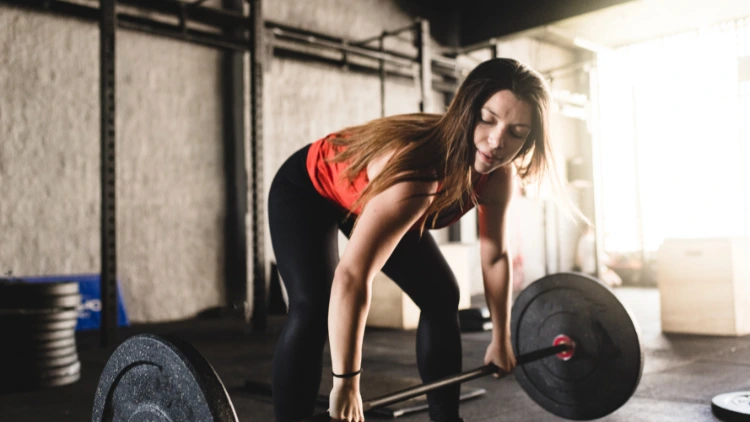
Source: Igor Alecsander via Canva.com7
For targeting the lower back, hip, and glute development, the conventional deadlift is optimal.
Sumo Deadlifts
Sumo deadlifts, on the other hand, require the lifter to have a wider stance than the standard version, which reduces the range of motion and allows the lifter to pull a slightly heavier weight. This variation is best for lifters with longer limbs, as it allows them to get into a deeper position which helps to activate the quads more.
It also activates the quads more than the traditional deadlift, so for those looking to prioritize the development of the ‘teardrop’ on their leg, the sumo makes a lot of sense to perform. Lastly, it offers the benefit of needing to raise the bar a shorter distance to complete the movement, allowing a more upright starting position, so it is a good starting variation of the deadlift.8
Pause Deadlifts
Pause deadlifts work exactly as they sound. About halfway through the concentric, the lifter pauses, holding the bar level while the legs are partially extended.
This places the lower back, quads, and core under a high degree of tension since they have to stabilize weight in an uncommon position. Some people will sometimes pause on both the concentric and eccentric to make it slightly more difficult to complete.
Similarly, since the legs are partially extended in an abnormal position, it forces the lifter to brace in a way that the torso is not used to, potentially developing better overall form throughout the entirety of the movement.
While they have not been researched in an official capacity, general consensus in the bodybuilding community says that pause deadlifts are ideal for those who want to build strength in the starting position, which is quite common for any sort of pause variation of weightlifting exercises, but it also helps to target the core and glutes to a greater extent.
During a pause deadlift, the bar is pulled off the floor like in a normal version, but stops being raised around 1 inch off of the ground, forcing the lifter to tighten their core and synchronize their glutes with their quads to hold an isometric contraction without letting the lumbar spine round.
Overall, while this may not lead to substantial or even noticeable strength gains in the lower body, it can safely be assumed that performed paused deadlifts can be highly beneficial to lock in better overall form by focusing on isometrically contracting the glutes and core.
Deficit Deadlifts
Deadlifting from a deficit is a great variation as they require the lifter to stand on an elevated surface, which increases the range of motion and activates the glutes and hamstrings to a greater degree since they are stretched more so than in the traditional deadlift. Like pause deadlifts, deficit deads are great for training lifters to be more aware of their form being especially effective at forcing the torso to maintain an upright position.
The main benefit of the deficit deadlift comes from the greater degree of knee flexion required to initiate the movement, simultaneously placing the quads and lower back under a greater degree of strain when compared to the traditional deadlift. However, there is quite a bit of debate in the bodybuilding community about deficits and if they are actually effective.
In general, the common consensus seems to be that using deficit deads as a way to push through a strength plateau is a good idea, but other than that, deficit deadlifting is simply not that beneficial. Many people do not even have good enough mobility to perform a proper deadlift, so making the starting position even more difficult and potentially leading to lower back rounding can be an easy recipe to cause an injury.
There are many different types of deadlifts but these are the main ones. To recap, the conventional deadlift is good for all-around strength and the sumo deadlift is good for people with long limbs or those who want to prioritize quad growth.
The pause deadlift helps to target better form, and the deficit deadlift is especially good for achieving a better mind-muscle connection with the legs.
Power Clean Variations
Clean & Press
The clean and press begin with the lifter to lift a weight from the ground in one fluid motion, then press it overhead. This is different than the traditional power clean in that the lifter must first use their hips to lift the weight, but then press it overhead using the shoulders, ending it standing straight up.
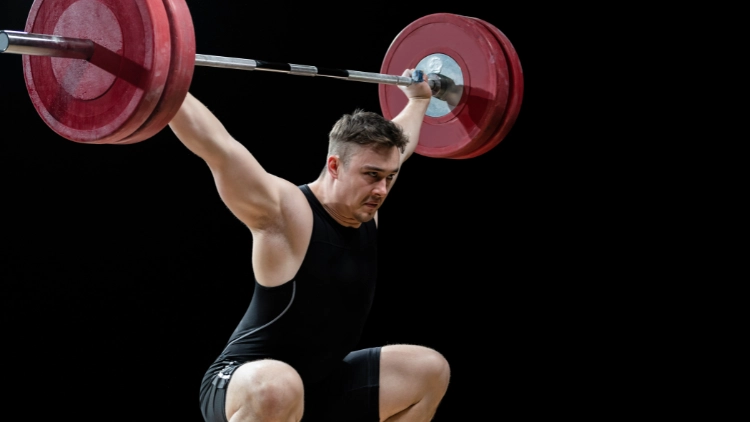
Source: Tashi-Delek via Canva.com9
It is an excellent exercise for overall athleticism but adds another layer of difficulty on top of the power clean by ending the movement with an overhead press.
For those who want to tack on a bit more volume onto their shoulders, performing the clean and press on a lower body or leg day is a good idea. Keep in mind that the shoulders will be the limiting factor here, unless a person’s legs are severely underdeveloped, so performing the clean and press will likely help to develop shoulder strength, but not so much in the legs.
Even still, it will help train the lower body to hinge and thrust properly which has good carryover to other lower body movements.
Squat Clean
Similar to other clean variations, the squat clean requires the lifter to pull a barbell off of the ground, flinging it up to their shoulders, but then drop into a full squat and catch the weight at the bottom of the squat, finishing it by pressing back up into a standing position. Since there is no overhead press portion when performing the squat clean, this clean variation targets the legs better than any other, forcing the lifter to develop greater hip mobility and overall leg stability.
Compared to the clean and press, the squat clean can be loaded more heavily, and the main target of it will be the legs in general. The starting portion of the movement is a deadlift which targets the lower back, hamstrings, and glutes, and the second portion of it has the lifter crouch down into a very deep squat with a high degree of knee flexion, targeting the quads.
One should expect to develop a good level of flexibility in the legs by performing the squat clean.
Hang Squat Clean
The hang squat clean differs from most versions of the clean because it starts with the lifter standing up and the barbell at hip height. Then, pushing the hips back slightly, performing the beginning portion of a Romanian deadlift, the bar is lowered towards the ground, and is then flung upwards and is caught at the bottom of the squat, with the legs subsequently pressed back up to standing.
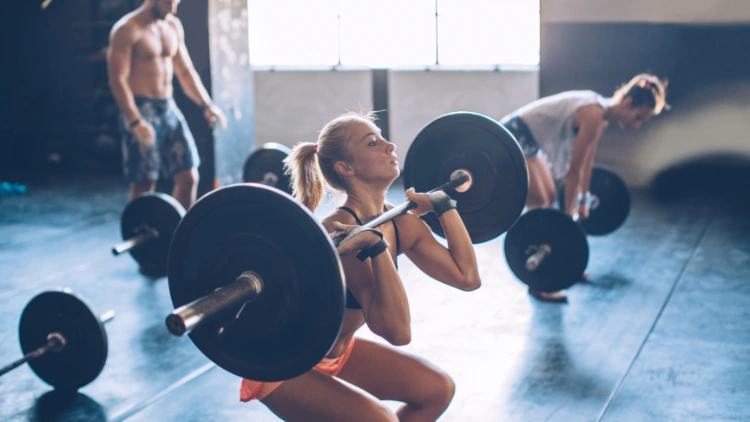
Source: svetikd via Canva.com10
This is certainly one of the harder variants for the clean when it comes to form, but it is also slightly less intensive on the lower back because there isn’t a pull from the floor to begin the movement, but that does make it target the hamstrings slightly more than other clean variations.
Dumbbell Squat Clean
This is essentially the same movement as the squat clean but performed with dumbbells instead. To perform the dumbbell squat clean, the lifter holds a pair of dumbbells in their hands, then lifts the weight from the ground, dropping into a full squat and catching the weight with knees bent at 90°, subsequently pushing out of the squat into a standing position.
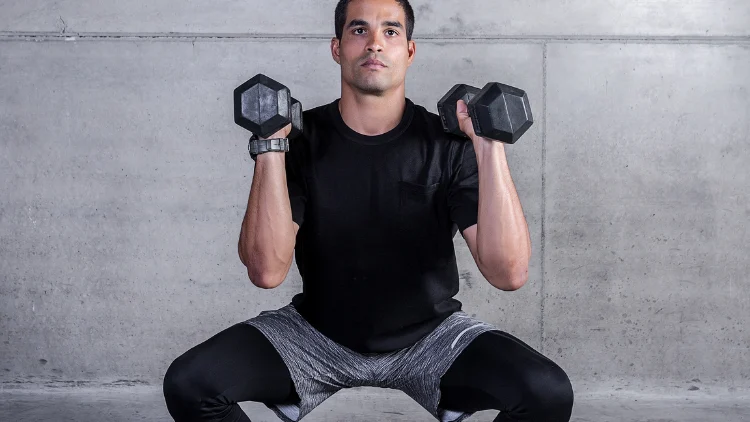
Source: Juan_Algar via Canva.com11
This variation is good for those who want to correct any muscular imbalances they have side-to-side since there is a weight that must be stabilized in each arm.
Squat Clean Thruster
The squat clean thruster is likely the most advanced version of the clean, requiring the lifter to perform the aforementioned squat clean, then immediately press the weight overhead. This is a great exercise for developing explosive strength and power in the lower body, as well as teaching the lifter the importance of transitioning from one movement to the next quickly and with precision.
But, similar to the clean and press, the squat clean thruster will be limited by the weight that can be pressed overhead. This means that the progressive overload potential for the legs and lower back is on the lower side, but as already discussed, using the clean as a way to progressively overload is not optimal — it should be primarily used as a way to develop better coordination.
Overhead Clean
Interestingly enough, beyond these variations, there are a few variations that require the lifter to start at the midthigh rather than on the ground; research shows that for maximizing power output, midthigh cleans are superior to both the hang clean and the power clean.12
Deadlift vs Power Clean Use Cases: When To Use Power Cleans &/or Deadlifts
While the deadlift and power clean offer benefits for similar muscle groups, there are a few reasons why a person would use one over the other.
Deadlifts Are Fantastic for Full-Body Strength
The deadlift is one of the most widely used exercises in strength training since it works virtually every muscle group in the lower body, as well as the core and forearms. A deadlift workout is excellent for overall strength development, as well as teaching a lifter how to properly keep their torso tight in compound movements, and to keep the scapula retracted.
It also uses some larger muscle groups in the body, primarily the entirety of the leg musculature, meaning quite a bit of weight can be pulled during the movement, more so than other compound exercises like back squats, bench presses, or overhead presses.
Best of all, the deadlift trains the erector spinae like no other — since it requires quite a bit of back stabilization and is hinged through the hips, locking out the movement requires a tremendous amount of strength in the spine to keep the spine and core protected. The erector spinae muscles’ core functions are to flex the spine forward and backward as well as side to side, which is taken through a significant range of motion throughout the deadlift.
So, to sum things up, if a person is aiming to develop a large amount of strength, especially in their back, forearms, and scapula, the deadlift is likely the optimal movement to go for.
Cleans Are Best for Athletes Developing Power & Speed
The squat clean, in particular, is a great exercise for teaching athletes how to explosively move weights out of the bottom of a deadlift. By performing a squat clean, a lifter learns to use their hips and core more efficiently to produce power and speed, which can then be utilized when deadlifting heavier weights.
This is especially important for athletes who need to generate high amounts of power quickly, including those who want to significantly improve their jumping or sprinting performance.13
Clean variations mentioned above, like the squat clean and clean and press, have benefits further than the traditional power clean can accomplish. Performing a squat clean effectively requires a person to deadlift immediately into a squat, building coordination between different muscle groups.
The clean and press also require the lifter to perform a deadlift, followed by an overhead press; this is a great way to increase power and stability all the way up the posterior chain, from the glutes up to the upper back.
All of this is to say – the clean is an extremely functional movement, which is what makes it different from the deadlift. While the deadlift prioritizes strength and overloading the body to its maximal limits, the clean has a focus on proper form, utilizing the entirety of the body’s musculature to get through the entire range of motion.
In it, it is crucial that a lower weight than the deadlift is used so that it can be performed safely; otherwise, it is simply an ineffective movement. For athletes who have to frequently shift their center of mass and bend and extend their limbs, the clean will functionally support them in developing stronger ligaments.
Overall, the deadlift is an excellent movement for developing strength in beginners and advanced lifters alike while the power clean is great for athletes who want to develop better full-body joint mobility, coordination, and overall athleticism. But, in the end, when it comes to the power clean vs deadlift, the deadlift has more applicable benefits to most lifters than the power clean.
References
1Dryburgh, I., & Psycharakis, G. (2017). Muscle Activation under Different Loading Conditions during the Power Clean. Performance Analysis in Sport, 16(2), 464-474. <https://doi.org/10.1080/24748668.2016.11868901>
2Barnes, M., Miller, A., Reeve, D., & Stewart, R. (2019). Acute Neuromuscular and Endocrine Responses to Two Different Compound Exercises: Squat vs. Deadlift. Journal of Strength and Conditioning Research, 33(9), 2381-2387. <https://pubmed.ncbi.nlm.nih.gov/28704311/>
3Choe, K., Coburn, J., Costa, P., & Pamukoff, D. (2021). Hip and Knee Kinetics During a Back Squat and Deadlift. Journal of Strength and Conditioning Research, 35(5), 1364-1371. <https://pubmed.ncbi.nlm.nih.gov/30335723/>
4McGuigan, M., & Wilson, B. (1996). Biomechanical Analysis of the Deadlift. Journal of Strength and Conditioning Research, 10(4), 250-255. <https://journals.lww.com/nsca-jscr/Abstract/1996/11000/Biomechanical_Analysis_of_the_Deadlift.8.aspx>
5Comfort, P., Allen, M., & Graham-Smith, P. (2011). Kinetic comparisons during variations of the power clean. Journal of Strength and Conditioning Research, 25(12), 3269-73. <https://pubmed.ncbi.nlm.nih.gov/22080325/>
6Hori, N., Newton, R., Andrews, W., Kawamori, N., McGuigan, M., & Nosaka, K. (2008). Does performance of hang power clean differentiate performance of jumping, sprinting, and changing of direction? Journal of Strength and Conditioning Research, 22(2), 412-8. <https://pubmed.ncbi.nlm.nih.gov/18550955/>
7Deadlift – Photos by Canva. (n.d.). Canva. Retrieved April 19, 2023, from <https://www.canva.com/photos/MAEJL_rdb_Q-deadlift/>
8Young man performing deadlift – Photos by Canva. (n.d.). Canva. Retrieved April 19, 2023, from <https://www.canva.com/photos/MAEFBaS1a8A>
9Weightlifting practice – Photos by Canva. (n.d.). Canva. Retrieved April 19, 2023, from <https://www.canva.com/photos/MAFbr6qRuqY-weightlifting-practice/>
10Young female athlete practicing weightlifting – Photos by Canva. (n.d.). Canva. Retrieved April 19, 2023, from <https://www.canva.com/photos/MAEEAG437zE->
11Young Male Weightlifter Holding Barbell – Photos by Canva. (n.d.). Canva. Retrieved April 19, 2023, from <https://www.canva.com/photos/MAEI2WI1Q0M-young-male-weightlifter-holding-barbell/>
12svetikd. Canva. Accessed 19 April 2023. <https://www.canva.com/photos/MAEJfo2SU0M-weightlifting-class/>
13Modern sportsman doing squat with dumbbells – Photos by Canva. (n.d.). Canva. Retrieved April 19, 2023, from <https://www.canva.com/photos/MADRb5r0qVM-modern-sportsman-doing-squat-with-dumbbells/>